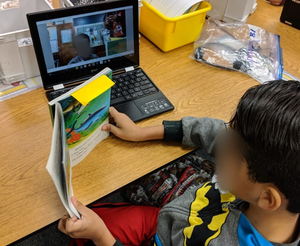
The YouTube Generation
One of my favorite tools to teach students is screencastify, which allows users to record a video of either their screen with audio, or what I call a “video selfie” using the webcam.
Whether I introduce this tool to 6 year olds or 16 year olds, it is inevitable that at least a few students view this as an opportunity to display their skills as a future (or current) YouTuber. Following the lesson, a few students often tell me they already have a YouTube channel.
Regardless of the learning objective that prompts the recording, a few students will begin their video by saying, “Hey everyone, this is (insert student name), I’m at school today and I’m going to teach you about (insert learning goal)”. To conclude the video a few students will add, “Be sure to subscribe to my channel for more great videos”. If you are familiar with the YouTube videos that students watch, you know that this verbiage sounds much like what they hear from their favorite YouTubers. Screencasting or other methods of video creation motivates students to engage with content, as it connects to a medium with which they are familiar.
A Social Media Society
While creating media in the classroom motivates students, it also meets a deeper need. Hip hop artist Tupac Shakur wrote a track entitled, “All Eyes on Me”. In the movie about his life, Tupac’s character remarks that his recent fame has affected his privacy and does not allow him to live as he wishes without criticism. Our students live in a world where social media permeates nearly every part of their lives. Parents and students alike post pictures, videos, and quotes online for the world to see. Even if this media is shared to only approved “friends” on the social platform, it is a mere screenshot and share away from public scrutiny.
We have a moral obligation to guide students in using media responsibly, lest their adolescent posting decisions result in consequences at a later date. Students need to learn the benefit of creating a digital tattoo that projects their best. As George Couros says, “We need to make the positives so loud that the negatives are almost impossible to hear”. When we provide students with the opportunity to publish media we guide them in building a positive presence online.
The Power of an Audience
The power of publishing within the school setting provides students with a space to safely practice responsible posting of media, but it also leverages an authentic audience to validate students and provide internal accountability.

Teacher Rhonda Tyler asked her summer school students why they insisted on coming in before school, during lunch, and after school to practice a single line they were to say in front of a green screen regarding their learning. The students remarked, “Ms. Goyette comes in everyday and takes pictures, sometimes even videos. We might end up on Twitter!” As you can see, the students did end up on Twitter. While the tweet did not receive many likes or retweets, the mere idea that it was available to the public provided a feeling of permanence that gave students a reason to complete their best work.
Publishing = Validation
When I was a child, YouTube did not exist. I was unable to publish work to be viewable by the public. Regardless, I created physical books of stories I wrote and illustrated. I recorded myself pretending to be a radio announcer on a cassette tape. I drew cartoons which I then projected onto the wall a page at a time to make a movie studio for my audience of dolls and stuffed animals. In my work in classrooms of varied ages, I see that this urge to publish work still appeals to students.
When we publish our idea, whether it be via writing on physical paper, documenting in an audio format, or creating a video, our thoughts and imagination are validated. Our work has a greater purpose once it is manifest outside our minds and into the world. Video creates a feeling of permanence. Even as I write this blog, unaware of how many eyes will ultimately view the words, it is comforting to know that my written reflections will become a part of the world wide web, accessible by anyone at anytime. Imagine the value you bring to a student when you document their learning digitally, as if to say, “your individual thoughts and the work you created mean so much to me that I want you to make it permanent, to publish it to the world”.
Even as an adult, anytime I begin to doubt that my words in a blog may be beneficial, it is the encouragement from others that keeps me writing. The retweets, comments on Facebook, and thank yous in real life keep me writing. We can do the same to motivate our students.
Another Real Life Example
Educator and technology coach Adam Juarez leverages a global authentic audience to motivate the middle school and high school students in his district. The Cardinal Innovation Center is not only a physical space for students to grow, it is also a virtual space with galleries in which student work is displayed for the world to see. Adam remarks that students love to hear stories of educational authors and other teachers from across the world that share his students’ work with the educators and classrooms in their sphere of influence. This allows students to view publishing work as a way to not only showcase their learning, but also to inspire others to do the same. The students become inspiring role models.
Learn More
View the GooglePDWeek video for more info on expanding the walls of your classroom and leveraging the power of an authentic audience.
